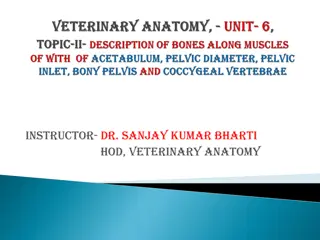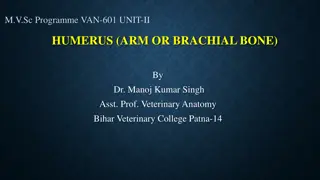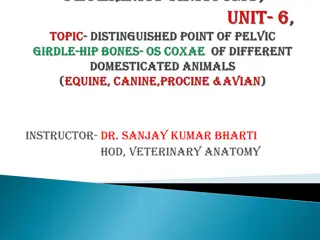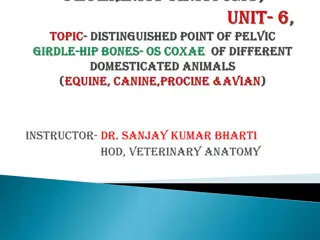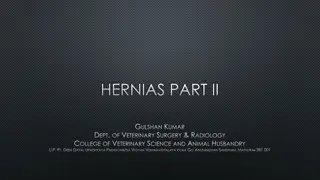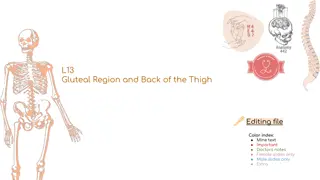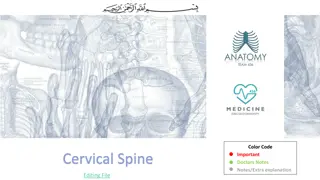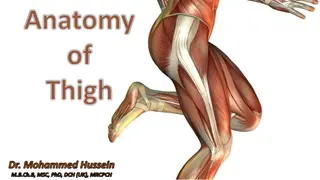Management of Foramen Magnum Stenosis in Achondroplasia Workshop Overview
Workshop on the detection and management of foramen magnum stenosis in individuals with achondroplasia took place on 6th April 2022. The event focused on challenges, screening protocols, intervention indicators, decision-making processes, and management strategies. Key outcomes include reaching an a
0 views • 11 slides
Veterinary Anatomy Overview: Pelvic Cavity and Bony Pelvis Structures
The instructor, Dr. Sanjay Kumar Bharti, explains the acetabulum, obturator foramen, sexual differences, and characteristics of sheep and goats related to pelvic anatomy. Details include the structure of the acetabulum, the large obturator foramen, pelvic cavity, and differences between male and fem
2 views • 18 slides
Anatomy of the Humerus Bone in Veterinary Science
The humerus bone, also known as the arm or brachial bone, plays a crucial role in forming the shoulder and elbow joints. It features a shaft with distinct surfaces and nutrient foramen. The proximal extremity includes a head, neck, tuberosities, and a bicipital groove for various muscle attachments.
0 views • 15 slides
Veterinary Anatomy: Pelvic Structures and Sexual Dimorphism in Animals
The article discusses the anatomy of the acetabulum, obturator foramen, pelvic cavity, pelvic inlet and outlet, and sexual differences in the pelvis, with a focus on sheep and goats. It covers the structure of these pelvic components and highlights the variations between male and female anatomies. D
0 views • 19 slides
Understanding Pelvic Anatomy in Veterinary Science
In this educational content, we delve into the intricate details of acetabulum, obturator foramen, pelvic cavity, pelvic inlet and outlet, sexual differences, and anatomical variations in sheep and goats. The explanations are accompanied by informative images to aid in better comprehension.
0 views • 19 slides
Role of Lymphadenectomy in Genital Malignancies
Pelvic and paraaortic lymph node evaluation is crucial in the surgical staging of gynecological malignancies. The goals of lymph node dissection are to determine disease extent and guide further treatment. Pelvic lymph nodes include common iliac, external and internal iliac, obturator, sacral, and p
0 views • 16 slides
Understanding Perineal Hernias in Veterinary Surgery
Perineal hernias are a common condition in uncastrated males but can also occur in females and cats. Weakness in the pelvic diaphragm can lead to herniation due to factors like hormonal disorders, prostatic diseases, and rectal issues. The symptoms include swelling in the perineal region, and diagno
0 views • 25 slides
Detection and Management of Foramen Magnum Stenosis in Achondroplasia Workshop
The workshop focused on understanding challenges and implications of foramen magnum stenosis in individuals with achondroplasia. It aimed to review protocols for screening infants, evaluate intervention indicators, and reach a consensus on optimal detection and decision-making processes for decompre
0 views • 11 slides
Understanding the Gluteal Region and Back of the Thigh
Learn about the anatomy of the gluteal region and back of the thigh, including the muscles, nerves, vessels, and important structures passing through the greater and lesser sciatic foramen. Explore the origins and insertions of the Glutei muscles for a comprehensive understanding.
0 views • 17 slides
Surgical Approaches to Foramen Magnum Lesions: Anatomy and Considerations
Surgical approaches to foramen magnum lesions involve understanding the anatomical structures, diameters, condyles, and contents of the region. Critical considerations include the choice of surgical approach based on the location and extent of the lesion, size, and nature of the pathology. Approache
0 views • 53 slides
Understanding the Cervical Spine: Anatomy and Function Explained
Explore the anatomy of the cervical spine, focusing on the 7 vertebrae, their unique characteristics, joint structures, and movements. Learn about typical and atypical vertebrae, key features like foramen transversarium, and the importance of vertebral arch components. Dive into how the cervical reg
0 views • 17 slides
Comprehensive Overview of Thigh Anatomy and Functions
Explore the detailed anatomy of the thigh, focusing on the medial compartment and structures like Gracilis, Adductor Magnus, and more. Understand the innervation, functions, and vascular supply of these thigh muscles. Dive into the complexities of the obturator artery and its branches as they relate
0 views • 23 slides

